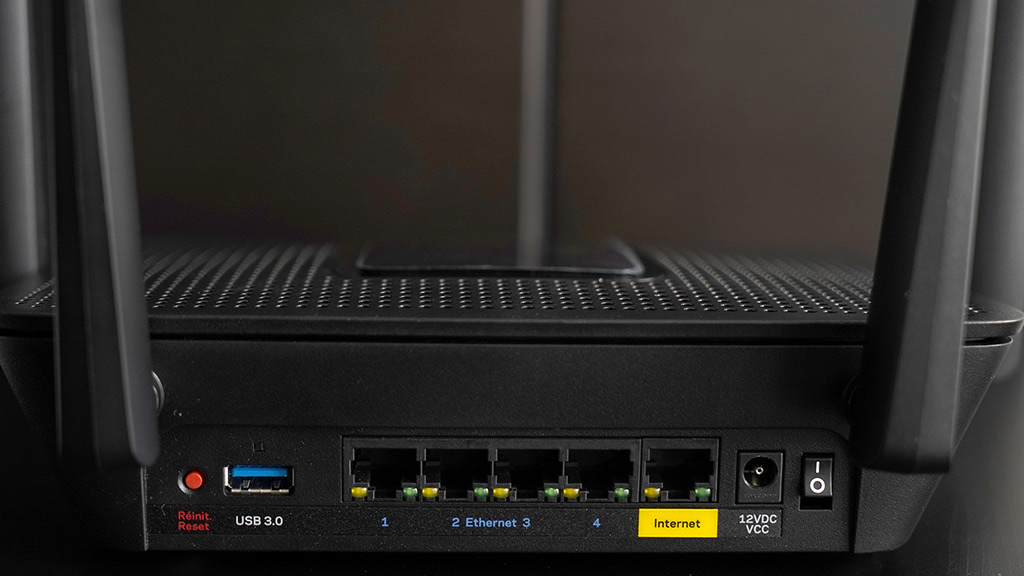
Despite making a router that looks more like any standard one from Linksys, the company has also kept the MR8300 open to mesh Wi-Fi setups.
This is a curious product for a couple of reasons. First, it’s a standalone router, meaning it comes on its own in the box, even though it supports Linksys’ Velop mesh system. Second, its internal components don’t create that much distance from the existing Velop routers already available.
I’ve identified some key differences between them, but ultimately, going with the MR8300 will depend on what kind of home you live in, and what setup you’re trying to achieve.
Design
Unlike the Velop systems that come in a tri-band (three-pack or two-pack) or dual-band (three, two or single node), the MR8300 is a solo act (not to be confused with the EA8300). It doesn’t come with any other nodes in the box, which essentially means that mesh networking is elective on your part. You can decide whether you want to add a node after setting this up.
Technically, you can already do that with a Velop Dual-Band single node, except the MR8300 offers a few benefits. It has faster speed, better overall range, and more wired connectivity options. In other words, it should function perfectly fine on its own without other nodes to spread out as a mesh.

Then you have the additional ports. You get a dedicated Ethernet WAN port (the yellow one the modem connects to), plus four extras to plug in whatever you need. The USB 3.0 port, disappointingly, isn’t open to anything yet. As of this review, I wasn’t able to use it for external storage. All these additional ports contrast with the dedicated Velop units, which only have two Ethernet ports available, and no USB ports.
The MR8300 is more like the tri-band Velop system in that it uses two bands on the 5GHz frequency. One is for a dedicated Wi-Fi network, the other a dedicated backhaul that it would use to communicate directly with Velop nodes, should you set them up. On its own, the extra band doesn’t really offer a tangible benefit.
Four antennas stick out to angle the signal, though the MR8300 does support MU-MIMO (multi-user, multi-input, multi-output) for better bandwidth allocation to devices also supporting it. Beamforming+ technology and band steering do help make the network more efficient behind the scenes.

Setup
Setting up the MR8300 was really no different than any other Linksys router, though it follows the same instructions and guidelines the Velop does. You can use the iOS or Android app to run through it rather than have to go with a computer.
Normally, I would have been up and running in minutes, but I ran into a snag because I was adding it to an existing Velop setup. If you’re planning on doing that, it’s not as simple as just inserting the MR8300 into the system. You have to install and set it up first, reset all the nodes, and then add them all over again one at a time.
The trick to doing this was to not log into my Linksys account first. The app recognized the router without a login, so I started the process that way. I followed the steps and had the MR8300 running in short order. To transition all devices over, I used the same SSID and password. From there, I went about re-adding the nodes.
Bear in mind that the experience is different if you’re just setting this up on its own. With no nodes to add or a Velop system to reconfigure, the MR8300 could be up and running in minutes. If you choose to add a node later, it’s easy to do.
Little has changed on the app side, too. You can set up a guest network limiting visitors to Internet access, yet no network controls, like accessing networked storage, printers and router administration. Parental controls can still restrict a device’s access to the Internet, blocking up to 10 websites. You can also schedule restrictions through the app, something that used to be browser-based only.

Performance
I got to assess the MR8300, both on its own, and as part of a Velop mesh. It’s a very capable and fast router in its own right. The range is also better than I anticipated, with lower dropoff than I would’ve experienced with a Velop node on its own.
Still, there were weak zones in areas that Velop nodes helped cover. And it wasn’t just that. It was also the improved throughput the nodes enable. It’s one thing to connect to Wi-Fi, but it’s another for it to be fast and robust wherever you roam at home.
Networking experts seeking greater control won’t be pleased with the limitations imposed here. Sure, there’s MAC filtering, port forwarding, DNS settings, and a few other things, but customization isn’t a selling point here. The WRT3200ACM, for instance, would provide more of that openness. However, that router can’t work with Velop nodes to create a mesh.
On its own, the MR8300 is most effective in smaller homes, like condos, apartments or townhouses, where the range is constricted to the actual living space. Spread out the square footage with more concrete, brick, and metal, and signal degradation becomes a bigger issue. That’s where I think the router’s strength lies. You can add to the mesh as you see fit, rather than going all in on a bundle.
Is there anything truly extraordinary going on here? No, not really. It’s a steady router on its own with the ability to get better when adding nodes to it. The app offers some decent customization, and you can prioritize bandwidth to certain devices if need be.
Having the extra Ethernet ports was convenient for me, as it always is. I plug in my Philips Hue Bridge, Arlo Base Station, powerline adapter and desktop computer into it.

Final Thoughts
Linksys took a modular approach with the MR8300. By not including any nodes in the box, it puts the onus on you to decide whether you want to expand your Wi-Fi network or not. So, you get the features of a Velop router without committing to a full package.
I’m disappointed the USB port doesn’t do anything yet, and hope that changes soon. One of the biggest things Velop units lack is USB support. The MR8300 teases users with a fast port that is currently dormant. A future firmware update could change that, and I would expect something to happen sooner than later.
The fact the router doesn’t support the next-generation AX standard (also known as Wi-Fi 6, Wireless-AX or 802.11ax) might be a drawback for users wanting a future-proof purchase. But at this point, it’s not clear how long it will take for AX to catch on, since devices have to support it, too.
The Linksys MR8300 Max-Stream Wi-Fi Router is coming soon.




As far as I can find, there’s no possibility to make a backup from the settings. In case of a powerfailure you can start all over again. Same problem when you use a node as a modem. For me that’s the only reason why I should buy it.
Comments are closed.